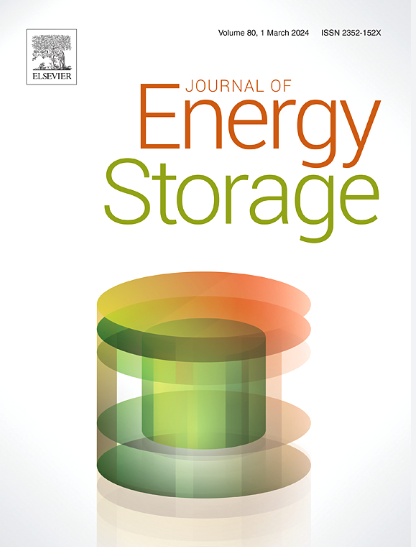基于田口模型参数化的锂离子电池温度估计实验与数值研究
IF 8.9
2区 工程技术
Q1 ENERGY & FUELS
引用次数: 0
摘要
锂离子电池的精确建模是保证其可靠高效运行的关键,而温度预测与模型精度密切相关,这是本研究的主要目的。在各种电池模型中,以等效电路模型(ECM)最为普遍,通常采用混合脉冲功率特性(HPPC)测试进行参数辨识。本文对基于田口方法的模型参数化锂离子电池的温度估计进行了实验和数值研究。四个关键的HPPC测试参数——脉冲时间间隙、放电脉冲时间、放电脉冲C率和休息时间——分析了它们在不同工作温度(- 10°C、25°C、40°C)下对ECM性能的影响。该方法包括使用田口法进行系统的HPPC试验设计,然后进行详细的参数识别。利用Fluent软件对从这些HPPC剖面得到的ECM参数进行了进一步的数值分析。该研究通过开发特定于每种温度和放电速率的模型,为电池在实际应用中的性能提供了更精确的表示。在不同的工作温度和放电速率(1C、3C、5C和7C)下,对数值结果和实验结果进行了比较。采用方差分析(ANOVA)来评估这些参数对电池芯温度精度的影响。结果表明,放电脉冲c率在所有温度下都起着至关重要的作用,同时也表明,在较高温度和放电速率下,脉冲时间间隙变得越来越重要,而在较低温度和放电速率下,放电脉冲时间和休息时间的影响更大。本文章由计算机程序翻译,如有差异,请以英文原文为准。
Experimental and numerical study for temperature estimation in lithium-ion cells using Taguchi-based model parameterization
Precise modelling of Li-ion batteries is essential for ensuring their dependable and efficient operation, and temperature prediction is closely related to model accuracy, which is the main aim of this study. Among various battery models, the equivalent circuit model (ECM) is the most prevalent, often employing the hybrid pulse power characteristic (HPPC) test for parameter identification. This paper presents an experimental and numerical investigation into temperature estimation for lithium-ion cells using model parametrization based on the Taguchi method. Four key HPPC test parameters—pulse time gap, discharge pulse time, discharge pulse C rate, and rest time—are analysed for their effects on the performance of an ECM across various operating temperatures (−10 °C, 25 °C, 40 °C). The methodology involves a systematic HPPC test design using the Taguchi method, followed by detailed parameter identification. The ECM parameters obtained from these HPPC profiles are further analysed numerically using Fluent software. The study provides a more precise representation of the battery's performance in real-world applications by developing models specific to each temperature and discharge rate. A comparison is made between the numerical and experimental results across different operating temperatures and discharge rates (1C, 3C, 5C, and 7C). The Analysis of Variance (ANOVA) was employed to evaluate the influence of these parameters on battery cell temperature accuracy. The results showed the critical role of discharge pulse C-rate across all temperatures, while also indicating that pulse time gap becomes increasingly important at higher temperatures and discharge rates, whereas discharge pulse time and rest time are more influential at lower temperatures and discharge rates.
求助全文
通过发布文献求助,成功后即可免费获取论文全文。
去求助
来源期刊

Journal of energy storage
Energy-Renewable Energy, Sustainability and the Environment
CiteScore
11.80
自引率
24.50%
发文量
2262
审稿时长
69 days
期刊介绍:
Journal of energy storage focusses on all aspects of energy storage, in particular systems integration, electric grid integration, modelling and analysis, novel energy storage technologies, sizing and management strategies, business models for operation of storage systems and energy storage developments worldwide.
 求助内容:
求助内容: 应助结果提醒方式:
应助结果提醒方式:


